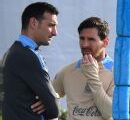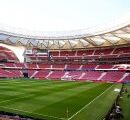Kicking off on Jan. 17, 2026, at Auckland’s famous Eden Park, the OFC Professional League, even if you might not have heard of it until now, is one of the most ambitious footballing projects in recent memory.
Covering the vast expanse of the Pacific, the FIFA-backed league will seek to bring professional football to not just one country for the first time but an entire confederation, with a view already towards expanding as far as the United States.
Here’s all you need to know about soccer’s newest professional league.
What is the OFC Pro League?
The OFC Pro League is a new, professional competition that has been set up by the Oceania Football Confederation (OFC), with the support of FIFA. Given their small size and the relatively nascent stage of its footballing development — New Zealand is the largest nation in the region — none of the OFC’s members have previously been able to support a fully professional competition, which this cross-confederation competition seeks to address.
In providing a new professional destination, it’s hoped the competition will help to raise the level of football in the OFC, which now holds a direct qualification slot to the FIFA World Cup under the newly expanded 48-team format. The competition will also provide a stronger pathway and platform for players from the Pacific to earn moves to clubs in Australia, Asia, and the rest of the world.
– Icicle kick?! Crazy goal helps win Canadian Premier League final
– A-League of their own: Sydney FC release stunning Jacaranda kit
– Latvian league star beating Mbappé, Haaland in Golden Shoe race
«To be accepted into this professional league is already huge for us,» Solomon Islands technical director Moses Toata told ESPN. «It means a lot of opportunities for coaches, for players, and for football in the country. It will change a lot of things; the way we look at football, the way we approach football.
«The changes that the professional league will bring to player development, there’s aspiration, even for the young ones. They will look up to the pros in the league, and say: ‘That’s where I want to be.’
«We just don’t [presently] have the right environment to nurture them and to develop the talents. We do have a lot of younger fans coming up, and I can say, with this league, I think this will increase the opportunity for more players coming up through the ranks. For our youth development programs, to our national academy program, and hopefully, in the future, we can see them at this stage.»
Which clubs will play in the OFC Pro League?
The inaugural edition of the competition will field eight teams, featuring a mix of existing and newly created entities. New Zealand is the only nation with two representatives, with Auckland FC representing the country’s North Island, and South Island United (rebadged from Christchurch United) representing its South.
Auckland FC (Auckland, New Zealand)
Bula FC (Fiji)
PNG Hekari (Papua New Guinea)
Solomon Kings (Solomon Islands)
South Island United (Christchurch, New Zealand)
South Melbourne (Australia)
Tahiti United (French Polynesia)
Vanuatu United (Vanuatu)
What’s the format of the OFC Pro League?
The new competition will run from January through to the end of May, with each entrant playing a minimum of 17 games. Teams will initially face each other twice across a series of circuit rounds planned to be staged across Auckland (New Zealand), Port Moresby (Papua New Guinea), Melbourne (Australia), Honiara (Solomon Islands), Lautoka (Fiji), and Suva (Fiji). Full fixtures are yet to be released.
Following the circuit series’ conclusion, the four sides with the most points will be split off into a «leaders» group, and the bottom four will be placed into a «challengers» group. Following another round-robin, the three highest-ranked sides from the leaders group will advance to the semifinals, while its bottom-placed side will face the highest-ranked side from the challengers group in a playoff to determine the final semifinal spot.
The single-leg semifinals and final will then be played in a central location, with Eden Park set to host these fixtures in the first year.
What’s at stake in the OFC Pro League?
Beyond earning the right to call themselves the champions of the Pacific, the winner of the OFC Pro League will secure a place in the FIFA Intercontinental Cup, while team’s performances in the competition on a quadrennial basis will be used to determine Oceania’s entrant at the newly reformatted FIFA Club World Cup.
How is the OFC Pro League being funded?
Clubs will be required to cover the costs of their own personnel, but the OFC has committed to subsidising the first four years of the competition with a US$40 million investment, which itself has been made possible thanks to the financial backing of FIFA.
Speaking at a launch event for Fijian outfit Bula FC, Fiji Football Association president Rajesh Patel, who also serves as a member of the OFC Executive Committee and the FIFA Council, claimed the competition would receive a four-year, US$20 million investment from the Saudi Tourism Authority, saying «we are thankful for this investment, which makes professional football a reality in our region.»
Speaking at a launch event for the league in Auckland in October, OFC general secretary Franck Castillo wouldn’t comment on the prospect of Saudi money being used to help fund the competition, nor claims that such an investment would represent an attempt at «sportswashing.»
«We are still finalising. We cannot answer yet,» Castillo said. «We are formalising everything, but in due course we will announce all the funding, but let’s say that it’s secured.
«I won’t comment on that, but when it comes to partnerships, I will explain [at a later date].
«We’ve got a good reason to partner with the people who want to partner.»
The Pacific has seen a significant amount of investment in sports in recent years, mostly tied to broader geopolitical maneuvering. China invested more than $US100 million in infrastructure for the 2023 Pacific Games in the Solomon Islands — which was described as a gift, not a loan — while the Australian Government has partnered with the NRL to place a new franchise in Papua New Guinea.
Are there any roster or spending restrictions in the OFC Pro League?
The OFC Pro League will not feature a salary cap but will have limits on the number of foreign players a team can field. In addition to fielding an unlimited number of players drawn from within their country, entrants will be allowed to field three players from the OFC in their squads, in addition to a further three players drawn from anywhere in the world.
Vanuatu United has already announced the signing of former Brisbane Roar goalkeeper Matt Acton and Australian defender Hassan Ramazani ahead of the opening season, while PNG Hekari — Papua New Guinea’s most successful side, that has rebranded from Hekari United — have signed Brazilians Erick Joe, Kaûe Silva, and Rafael Chaves.
Is there VAR in the OFC Pro League?
Yes, the cameras necessary to implement video review will be placed at every stadium that hosts games during the competition, with training and match simulations already commenced for OFC VAR officials, who will work out of an Auckland-based hub, under the guidance of former UEFA Champions League final official Mihaly Fabian.
Who has the OFC Pro League broadcast rights?
While OFC officials hope the league eventually grows to the point where it is attracting broadcast revenue, the OFC Pro League will be available globally and for free on the FIFA+ platform, where games from various Oceanian club and international countries are currently broadcast.
The OFC says that broadcasts will be produced using a five-camera setup, with commentators — drawn from the ranks of local media at the various locations where the competition will be staged — that will visit during its circuit series, calling games on location.
What’s the future of the OFC Pro League?
Long-term, it’s the hope of clubs that the competitions will expand and become financially viable enough to adopt a home-and-away format. Castillo indicated that the OFC aspires to expand the league by two as soon as possible, but that this will depend on funding, with other officials telling ESPN that such an aspiration would largely depend not only on the strength of new applicants for the competition but also on how well foundational clubs established themselves.
American Samoa, Cook Islands, New Caledonia, Samoa, Tahiti, Tonga, are full OFC members that aren’t yet represented in the new competition, while Kiribati and Tuvalu are associate members that are likewise unrepresented. With Asian Football Confederation member Australia represented via South Melbourne, OFC officials have already flagged a willingness to take the league outside the confederation and have previously expressed an openness to a team based in the United States.
«The league needs to grow,» Castillo said at the launch event. «We are starting now with eight teams, because it’s about funding, and we have the funding for eight teams. But we want to have more than eight teams in the future. And we are very confident with that. The first year is always the most difficult, because people do not believe in this thing.
«We know that this will be a major project, not only for the region, but for the world. Because I can tell you, the world will talk about this league. We are the only confederation without professional football, and we will now demonstrate that we can do it.
«And you will see amazing results. And because of the amazing results, people will talk about this league around the world. That will be a human story. So I’m very confident that we will secure more funding, and with more funding, we can get more than eight teams. At the moment, it’s a circuit series. If we increase more than 10 teams, then we have like a conference League, and we can have more and more teams.»
Did you say a team from the United States could play in the OFC Pro League?
Yes, a team from Hawaii, to be precise. With Honolulu a nine-hour flight from Auckland, Castillo said that placing a team in Hawaii remains an aspiration of the OFC, which would not only maintain the Pacific nature of the competition but also give it a foothold in the United States, in theory giving it a greater ability to commercialise.
«It’s about market as well, to open to the U.S. market and the Americas market,» he said.
Why are Auckland FC allowed to play in the OFC Pro League?
Auckland FC somewhat stand out among the OFC Pro League’s inaugural entrants in that they’re the only club that was already playing in a professional competition: the A-League Men. Bankrolled by American billionaire businessman Bill Foley, who also owns AFC Bournemouth in the Premier League and the Vegas Golden Knights in the NHL, Auckland FC are the defending premiers of the A-League, finishing atop the table as an expansion franchise in 2025.
Despite the A-League and OFC Pro League seasons overlapping, the club plans to maintain a presence in both competitions heading into the future, with football director Terry McFlynn, rather than the A-League coach Steve Corica, to lead the side into the Pacific. This has necessitated extra restrictions on their roster: limited to fielding a maximum of three players over the age of 23 contracted to their A-League side. They will, however, be allowed to field further players over the age of 23 if they aren’t registered for the A-League. Both Auckland and the OFC insist that the club won’t simply be fielding a reserve side in the OFC Pro League, with it expected that it will look to recruit extra players, especially from the Pacific, for its new commitment.
Importantly, Auckland FC will also be eligible to qualify for the FIFA Club World Cup through the new competition, and while they’re prevented from fielding their strongest squad in the OFC Pro League, the placements of transfer windows surrounding the global club showpiece would allow them to do so in the Club World Cup without running afoul of their registration restrictions.
«The winner goes to the Intercontinental Cup each year, and then the most successful team every four years gets to go to the Club World Cup,» Auckland chief executive Nick Becker told ESPN. «That’s something that isn’t possible for us in the A-League setup. Even if we win the A-League, as we did when we won the Premiers’ Plate last season, we didn’t qualify for the Asian Champions League because we can’t, because we’re an Oceanian team. This now gives us the opportunity to go out there and compete on those global stages.»
Why is South Melbourne, an Australian team, allowed to play in the OFC Pro League?
South Melbourne also stand out given they’re based in Australia, which left the OFC to join the Asian confederation in 2006. South’s presence in the league — and the absence of A-League side Wellington Phoenix — has raised many an eyebrow in soccer circles.
South Melbourne have a long, storied history. Named Oceania Club of the Century in 2010, the then South Melbourne Hellas were a stalwart of the Australian top flight — the NSL — until its demise in 2004. Omitted when the A-League was founded in 2005, South have been fighting for top-league football ever since. Now a foundation member of the new Australian second-tier, the Australian Championship, South will maintain their existing commitments alongside the OFC Pro League and will be required to make the step up from a semi-professional level to compete.
However, mirroring the situation confronting Kiwi-based sides Auckland and Wellington in the A-League, South will not be eligible to qualify for FIFA international tournaments through the OFC Pro League. They will, though, be eligible to receive a share of the FIFA World Cup payments that will be redistributed throughout the league by the OFC to ensure competitive balance.
«It’s a little bit like the same situation that we’ve got with the A-League,» Castillo said. «The A-League has invited two teams from New Zealand [to compete] and we believe that we should have done the same [for the OFC Pro League].
«It’s also a practical situation. We open the Australian market and we open the Asian markets [with South Melbourne’s entry]. Therefore, it’s a win-win situation.
«Australia was part of the OFC before. And there’s a long history with South Melbourne. They have been named the club of the century for Oceania. And I think that they are very proud [of that]. It was a competitive [bidding] process, with independent members to select the clubs, and we are happy that, finally, South Melbourne can come back with us.»
How competitive will the OFC Pro League be?
On a surface level, fully professional Auckland, even with the restrictions on overaged players they will operate with, appear to be the clear favourites for this new competition — especially considering semiprofessional Kiwi outfit Auckland City ran roughshod over the OFC Champions League for years. South Melbourne, meanwhile, are one of the most well-backed clubs outside the A-League in Australia and, on a surface level, would seem their closest rivals.
OFC officials, however, are confident that both clubs will face plenty of challenges in the new season.
With the opportunity to play in a professional competition, many of the Pacific-based clubs are expected to almost become quasi-national teams. Stéphane Auvray is the head coach of both Bula FC and Fiji, Samuel Garcia is set to lead both Tahiti United and Tahiti, and German tactician Lars Hopp will have roles with both Vanuatu United and Vanuatu.

















